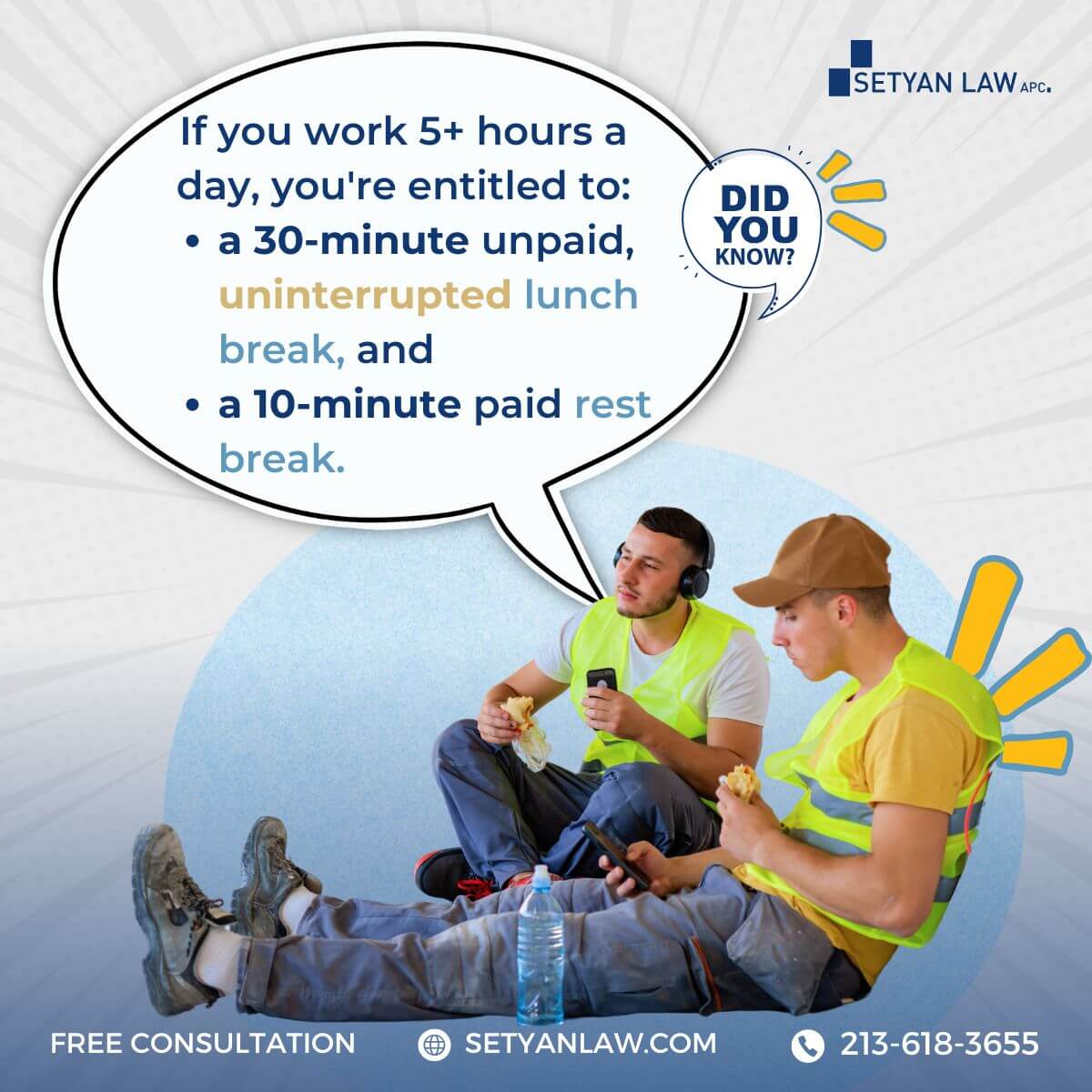Updated September 22, 2025
California Labor Code Section 512: 30-Minute Meal Breaks
California Labor Code Section 512 is a state statute that establishes mandatory meal break requirements for employees working in California. This provision mandates that employers must provide employees with a meal period of not less than 30 minutes when they work more than five hours in a single workday [1]. The primary purpose of this regulation is to ensure workers have adequate rest during their workday and to prevent employers from requiring continuous work without proper breaks.
According to the statute, the first meal break must be provided before the employee completes their fifth hour of work [1]. However, if an employee works no more than six hours in a day, this meal period can be waived through mutual consent of both the employer and employee [1]. This waiver must be voluntary and agreed upon by both parties.
For longer shifts, California Labor Code Section 512 requires employers to provide a second meal period of not less than 30 minutes when an employee works more than 10 hours in a day [1]. This second meal break can be waived only if the total shift is no more than 12 hours, the first meal period was not waived, and both employer and employee mutually consent to the waiver [1].
The law contains several industry-specific exceptions. The Industrial Welfare Commission may adopt orders permitting meal periods to commence after six hours of work if consistent with employee health and welfare [1]. Additionally, commercial drivers transporting nutrients from commercial feed manufacturers to remote rural locations may begin meal periods after six hours if paid at least 1.5 times the minimum wage and receive overtime compensation [1].
Further exemptions exist for employees in the wholesale baking industry covered by specific collective bargaining agreements that provide for a 35-hour workweek with five 7-hour days and rest periods of at least 10 minutes every two hours [1]. Likewise, employees in the motion picture and broadcasting industries have special provisions when covered by valid collective bargaining agreements [1].
For proper compliance, employers must relieve employees of all duties during the meal break, allow workers to use this time freely, and refrain from impeding or discouraging break usage [1]. While employers must provide the opportunity for these breaks, they are not required to force employees to take them [1].
Certain employee categories including construction workers, commercial drivers, security officers, and utility workers may have different meal break provisions if covered by qualifying collective bargaining agreements that expressly provide for meal periods and meet other specific requirements [1].
Meal break rules under Section 512
The California meal break law mandates specific requirements for rest periods during work shifts. Under Labor Code Section 512, employers must provide a meal period of not less than 30 minutes when an employee works more than five hours in a workday [2]. These breaks must commence before the employee completes their fifth hour of work.
Meal break durations and timing requirements vary based on shift length:
- For shifts under 5 hours: No meal break required
- For shifts between 5-6 hours: One 30-minute meal break, which may be waived through mutual consent [2]
- For shifts between 6-10 hours: One mandatory 30-minute meal break
- For shifts between 10-12 hours: Two 30-minute meal breaks, with the second potentially waived if the first was taken [2]
- For shifts exceeding 12 hours: Two mandatory 30-minute meal breaks
These meal periods must be completely uninterrupted. Consequently, employers cannot require employees to perform work duties during designated break times [3]. Moreover, employers may not discourage employees from taking their entitled meal breaks in any manner [3].
Notably, meal breaks under Section 512 are generally unpaid. Nevertheless, if an employer requires an employee to remain "on-duty" during their break, this period becomes compensable at the employee's regular rate of pay [1]. On-duty meal periods are permitted solely when the nature of the work prevents the employee from being relieved of all duties and when there exists a written agreement between employer and employee [1]. This written agreement must explicitly state that the employee can revoke it at any time.
Certain industries have specific exemptions or modifications to these general requirements. For instance, employees in the motion picture industry can take breaks after the sixth hour of work rather than the fifth [3]. Furthermore, employees covered by valid collective bargaining agreements in specific industries may have alternative meal break provisions [2].
An employer who fails to provide a completely uninterrupted 30-minute meal break must pay the employee a meal break premium equal to one additional hour of work at the employee's regular rate of pay [3]. This premium applies even if a meal break was provided but lasted less than 30 minutes, specifically when the decision to return to work before the 30-minute mark was not voluntary [3]. Importantly, this additional hour is not counted toward overtime calculations [1].
In addition to timing requirements, employers must designate suitable places for employees to eat when required to consume meals on premises [1].
Rest break rules and how they differ
Rest break requirements in California complement meal break regulations but follow distinct rules. Unlike meal breaks, rest periods mandate a 10-minute paid break for every four hours worked or "major fraction thereof" [4]. The term "major fraction" refers to any work period exceeding two hours [4].
The California Supreme Court's decision in Brinker Restaurant Corp. v. Superior Court clarified that employers must provide these breaks but aren't required to ensure employees take them [5]. Rest break requirements follow a specific schedule based on total hours worked:
| Hours Worked | Number of Required Rest Breaks |
|---|---|
| 0 to 3:29 | 0 |
| 3:30 to 6 | 1 |
| 6:01 to 10 | 2 |
| 10:01 to 14 | 3 |
| 14:01 to 18 | 4 |
Primarily, rest breaks differ from meal breaks in several important ways:
- Rest breaks are paid time whereas meal breaks are generally unpaid [4]
- Rest breaks are shorter (10 minutes) compared to meal breaks (30 minutes)
- Rest periods must occur during paid work time, not added to meal periods
- Employers must provide "suitable resting facilities" separate from toilet rooms [4]
Concerning timing, rest breaks should, when practicable, be scheduled in the middle of each four-hour work period [2]. For an eight-hour workday, this typically means one rest break before and one after the meal period, although this arrangement may vary based on practical considerations [2].
Essentially, employers must relieve employees of all duties during rest breaks and relinquish control over how employees spend their break time, as established in Augustus v. ABM Security Services, Inc. [5]. Employees cannot be required to remain on-premises or on-call during these periods [6].
Although employees may voluntarily choose to skip rest breaks, employers cannot pressure or encourage this decision [6]. If an employer fails to provide required rest breaks, the employee is entitled to one additional hour of pay at their regular rate of compensation for each workday a rest break is not provided [4]. Significantly, this is a separate penalty from meal break violations, as confirmed in United Parcel Service v. Superior Court of Los Angeles County [5].
Certain industries have limited exceptions to standard rest break rules, including 24-hour residential care facilities, performers engaged in strenuous physical activities, and certain on-site occupations in construction, drilling, logging and mining industries [4].
When can meal breaks be waived?
California Labor Code permits meal break waivers under specific circumstances, offering flexibility to both employers and employees while maintaining worker protections.
Waiver for shifts under 6 hours
Employees working shifts lasting more than five hours but no more than six hours may waive their 30-minute meal period through mutual consent with their employer [7]. This provision primarily applies to shorter workdays where employees might prefer to complete their shift without interruption. The law explicitly requires that both parties—employer and employee—must agree to the waiver [8].
Recent legal developments have clarified that these waivers can be established prospectively. In Bradsbery v. Vicar Operating, Inc. (2025), the California Court of Appeal confirmed that written, revocable meal period waivers for shifts between five and six hours are valid and enforceable [9]. These advance waivers must meet certain conditions:
- They must be voluntary
- Employees must understand what they're waiving
- Employees must have the ability to revoke the waiver at any time
- The waiver cannot be coerced [9]
Importantly, once a shift exceeds six hours, the meal period cannot be waived regardless of employee preference [8].
Waiver of second meal break under 12-hour shifts
For employees working longer shifts, a second waiver option exists. When an employee works more than 10 hours but no more than 12 hours in a day, they may waive their second 30-minute meal period [7]. Nonetheless, this second waiver is subject to two critical conditions:
- The total shift duration cannot exceed 12 hours [7]
- The employee must have taken their first meal break [7]
This means an employee cannot waive both meal periods in a single workday, regardless of circumstances [6]. Furthermore, employees working shifts longer than 12 hours must receive both mandatory meal periods without exception [10].
California employers commonly implement these waiver provisions in industries with variable or part-time scheduling [9]. The waivers must be properly documented, though they need not be reestablished daily—a standing waiver that complies with legal requirements is sufficient [11].
Penalties for violating Section 512
Employers face substantial financial consequences for failing to comply with California's meal and rest break requirements. These penalties represent a critical enforcement mechanism within the state's labor regulations.
Missed meal break penalties
When an employer fails to provide a compliant meal period as required by California Labor Code Section 512, they must pay the affected employee one additional hour of pay at the employee's regular rate of compensation for each workday the meal period is not provided [10]. This premium payment applies whenever a meal break is missed entirely, provided late (after the fifth hour of work), shortened to less than 30 minutes, or interrupted with work duties [1]. Courts have established that this additional compensation is classified as a wage rather than a penalty, thereby subjecting it to a three-year statute of limitations [12].
Missed rest break penalties
Similarly, if an employer fails to provide a required rest period, they must pay the employee one additional hour of pay at the regular rate of compensation for each workday when rest breaks are denied [4]. Importantly, this premium payment is separate from meal break penalties. The case of United Parcel Service v. Superior Court of Los Angeles County definitively established that employees are entitled to receive up to two separate premium payments per day—one for missed meal breaks and another for missed rest breaks [2].
How penalties are calculated
Premium pay calculations must use the employee's "regular rate of pay," which often exceeds the base hourly wage. This rate includes all compensation received during the workweek, such as hourly wages, commissions, and non-discretionary bonuses [13]. The maximum penalty for combined meal and rest break violations is capped at two hours of premium pay per workday, regardless of how many individual breaks were missed [14]. Critically, these premium payments must appear on the employee's next paycheck [14]. Employees can file claims for unpaid premium wages up to three years after the violation occurred [4].
What employers must do to stay compliant
To maintain compliance with California meal break law, employers must adhere to specific protocols beyond merely offering breaks. Proper implementation requires attention to several critical areas.
Relieve employees of all duties
Employers must completely relieve workers of all duties during break periods [4]. This obligation extends beyond simply allowing time away from work tasks. As established in Augustus v. ABM Security Services, Inc., employers must relinquish control over how employees spend their break time [2]. Practically speaking, employers cannot require employees to monitor work-related communications, remain on-call, or stay "on premises" during rest periods [15]. The California Supreme Court clarified that employees must have genuine freedom to use break periods as they choose [2].
Avoid discouraging breaks
Employers must refrain from creating workplace environments that implicitly discourage break usage. This includes avoiding scheduling practices that make taking breaks extremely difficult or pressuring employees to perform duties in ways that omit breaks [12]. Employers cannot create incentives to forgo legally protected breaks or influence employees to skip them [12]. Even with facially neutral policies, employers violate the law if the workplace reality discourages break usage through understaffing or poor management [15].
Maintain accurate records
Proper documentation serves as critical protection against potential liability. California law requires employers to track hourly employees' start and stop times, meal periods, and total hours worked [16]. These records must be maintained for at least four years, as wage and hour lawsuits can reach back this timeframe [16]. Documentation should include any waived meal breaks with explicit written agreements that acknowledge employees' right to revoke the waiver without fear of retaliation [17]. Employers should also train supervisors on proper record-keeping procedures and compliance policies [16].
References
[1] – https://www.shouselaw.com/ca/labor/wage-and-hour/meal-and-rest-breaks/lunch-breaks/labor-code-512/
[2] – https://www.calchamber.com/california-labor-law/meal-and-rest-breaks
[3] – https://bakerllp.com/labor-laws/california-labor-code-section-512/
[4] – https://www.dir.ca.gov/dlse/faq_restperiods.htm
[5] – https://mosey.com/blog/california-10-minute-break-law/
[6] – https://www.ottingerlaw.com/california/meal-breaks-and-rest-breaks/
[7] – https://law.justia.com/codes/california/code-lab/division-2/part-2/chapter-1/section-512/
[8] – https://www.yashlaw.com/articles/meal-break-waivers-waiving-worker-meal-breaks-in-california/
[9] – https://www.californiaemploymentlawreport.com/2025/05/fridays-five-california-court-confirms-written-meal-break-waivers-are-valid-what-employers-need-to-know/
[10] – https://www.dir.ca.gov/dlse/FAQ_MealPeriods.html
[11] – https://www.hansonbridgett.com/publication/250523-6000-ca-meal-break-waivers
[12] – https://www.dir.ca.gov/dlse/faq_mealperiods.htm
[13] – https://www.sacattorneys.com/articles/understanding-californias-meal-and-rest-break-rules-for-employers/
[14] – https://hrcalifornia.calchamber.com/hr-library/pay-scheduling/meal-rest-break
[15] – https://haelaw.com/rest-breaks-must-be-free-from-all-work-duties/
[16] – https://www.californiaemploymentlawreport.com/2025/03/california-employers-dont-get-caught-off-guard-5-essential-record-retention-reminders/
[17] – https://www.employmentlawworldview.com/california-court-of-appeal-affirms-enforceability-of-prospective-meal-period-waivers-us/
If you need employment litigation, call Setyan Law at (213)-618-3655. Free consultation.






